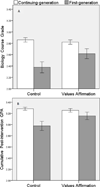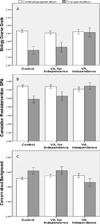Affirming independence: Exploring mechanisms underlying a values affirmation intervention for first-generation students
- PMID: 27176770
- PMCID: PMC4868407
- DOI: 10.1037/pspa0000049
Affirming independence: Exploring mechanisms underlying a values affirmation intervention for first-generation students
Abstract
First-generation college students (students for whom neither parent has a 4-year college degree) earn lower grades and worry more about whether they belong in college, compared with continuing-generation students (who have at least 1 parent with a 4-year college degree). We conducted a longitudinal follow-up of participants from a study in which a values-affirmation intervention improved performance in a biology course for first-generation college students, and found that the treatment effect on grades persisted 3 years later. First-generation students in the treatment condition obtained a GPA that was, on average, .18 points higher than first-generation students in the control condition, 3 years after values affirmation was implemented (Study 1A). We explored mechanisms by testing whether the values-affirmation effects were predicated on first-generation students reflecting on interdependent values (thus affirming their values that are consistent with working-class culture) or independent values (thus affirming their values that are consistent with the culture of higher education). We found that when first-generation students wrote about their independence, they obtained higher grades (both in the semester in which values affirmation was implemented and in subsequent semesters) and felt less concerned about their background. In a separate laboratory experiment (Study 2) we manipulated the extent to which participants wrote about independence and found that encouraging first-generation students to write more about their independence improved their performance on a math test. These studies highlight the potential of having FG students focus on their own independence. (PsycINFO Database Record
(c) 2016 APA, all rights reserved).
Figures





References
-
- Autor DH. Skills, education, and the rise of earnings inequality among the “other 99 percent”. Science. 2014;344:843–851. - PubMed
-
- Betts JR, Morell D. The determinants of undergraduate grade point average: The relative importance of family background, high school resources, and peer group effects. The Journal of Human Resources. 1999;34:268–293.
-
- Bullock JG, Green DP, Ha SE. Yes, but what’s the mechanism?(don’t expect an easy answer) Journal of personality and social psychology. 2010;98(4):550. - PubMed
-
- Chen X. U.S. Department of Education, National Center for Education Statistics. Washington, DC: U.S. Government Printing Office; 2005. First-generation students in postsecondary education: A look at their college transcripts. Retrieved from http://nces.ed.gov/pubs2005/2005171.pdf.
-
- Cohen GL, Garcia J, Apfel N, Master A. Reducing the racial achievement gap: a social-psychological intervention. Science. 2006;313:1307–1310. - PubMed
MeSH terms
Grants and funding
LinkOut - more resources
Full Text Sources
Other Literature Sources

